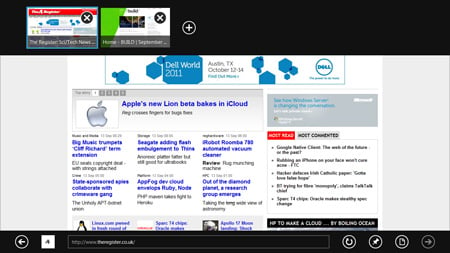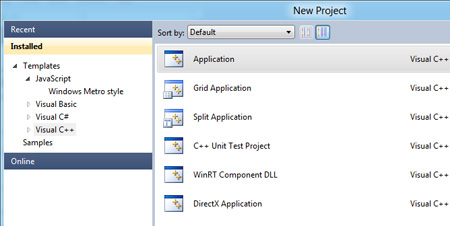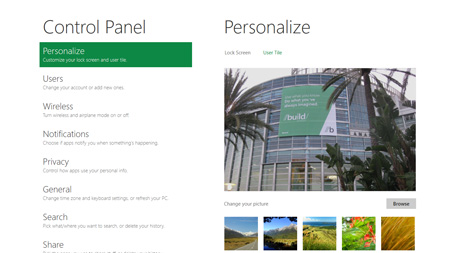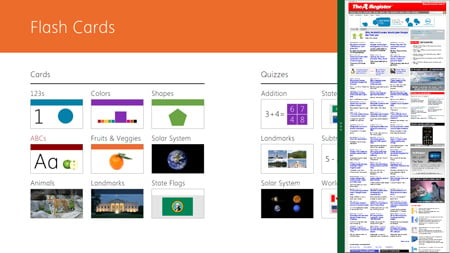Original URL: https://www.theregister.com/2011/09/13/windows_8_preview/
Windows 8: First contact with Microsoft Touch
Strong enough to ARMwrestle Android and iOS?
Posted in Software, 13th September 2011 16:05 GMT
Preview Microsoft is facing up to the million-dollar question: how does it compete with Apple's iPad and Google's Android when Windows was designed for keyboard and mouse rather than touch control?
Microsoft's answer has been to create a platform based on Metro, the design style in Windows Phone 7. Metro apps run full-screen without any surrounding chrome, which is why Microsoft calls it an immersive user interface. Microsoft has used the opening of its BUILD conference in Anaheim, California, today to deliver the first developer preview of Windows 8, the first version of Windows optimised for touch.
For all the tablet focus, users expect a Windows PC to run Windows applications, so Windows 8 also supports the traditional Windows desktop. In the current build, Windows 8 looks much like Windows 7, aside from the disappearance of the old Start menu in favour of pages full of Metro tiles.

IE goes Metro: new menus top and bottom vanish when you tap the page, for a full-screen view
The Metro UI is not just an alternate shell. Metro is built on a new native code, Windows Runtime (WinRT), which can be called from two alternative view engines. The first is XAML, the layout language used by Microsoft's Silverlight media player and Windows Presentation Foundation (WPF), driven by code written in C, C++, C# or Visual Basic. The second is HTML and CSS, driven by code written in Javascript. Microsoft notes that the Metro Software Development Kit (SDK) "also includes a subset of traditional Win32, COM and .NET Framework APIs".
Microsoft has promised to clarify the Windows developer story at BUILD. So far, it looks like this: Metro is a new platform, and while you will be able to port code from existing Windows applications, they will need to be rewritten. XAML and .NET are supported, but this is not Silverlight or WPF – though the Silverlight plug-in still runs in the browser. Microsoft does seem to be promoting the HTML and Javascript approach here at BUILD, but says XAML and .NET have access to all the same features.

The Windows 8 Developer Studio features a Visual Studio 11 early build
Windows Phone remains a separate platform. Windows group president Steven Sinofsky told the press ahead of BUILD that the different form factor means that running the same app on phone and tablet is not an immediate prospect. That is missing the point though; in principle Windows Phone could have its own cut-down version of WinRT, but instead it has Silverlight and XNA. It seems that Windows developers will have to live with this diversity for some time.
I was given a Windows 8 Intel-based tablet by Microsoft to try, just ahead of its public unveiling at BUILD. Windows 8 will also run on ARM, but Microsoft says the ARM build is not yet ready to show. Once set up, it boots from cold in around 10 seconds – impressive. Resume from sleep is near-instant.
Windows 8 opens to a lock screen. Password entered, you see the new Start menu, formed by Windows Phone-style live tiles in a horizontally scrolling view. Tap a tile to launch an app, which presuming it is Metro-style will open full-screen. Application menus are accessed by a quick swipe top or bottom, letting you access, for example, open tabs in Internet Explorer.
Metro Charms
Although Metro apps run full screen, with the right gesture you can swipe another app into view and then dock it, giving you two apps open together, with one occupying around 75 per cent of the screen.
One of the Metro tiles is called Desktop. Tap this one, and presto, you are back in the familiar Windows user interface, though this is as frustrating as ever if you try to run apps using touch alone. Our review sample came with Bluetooth keyboard, a dock and a stylus, and using these in combination made it work pretty much like a Windows 7 PC. Tap Start though, and you are back in the Metro world.

The Control Panel: an example of a touch-friendly Metro app just beware "More Settings"
Another key feature is called Charms. This is a menu of five icons which appears if you swipe the right edge of the screen. There are Charms for Search, Share, Start, Devices and Settings. From a user perspective, the Charms give a standard means of performing certain tasks. For example, select Share when in a picture app, and you can share your picture via any app that knows how to share pictures, such as Flickr or Facebook. Under the covers, this is done by a mechanism called Contracts, which apps implement either as providers or consumers.
While the Metro-style interface works well on the developer preview, it is hard to get the full flavour of it, since standard apps that were demonstrated to the press, including the email client, calendar and contacts are missing. Nevertheless, the Metro system is well optimised for touch and enjoyable to use.
Similarly, a new Windows Store was shown to the press but is not present in the review sample. Since BUILD is a developer conference, Microsoft is emphasising the speed and ease of use of the app submission process, which should take no more than 24 hours. Details of how the store will work are sketchy, but the company did let slip that only Metro apps will be allowed for ARM Windows, and that the Store will be the only way to install apps on ARM. This is significant, since it implies that Windows 8 on ARM will be an iPad-style locked-down platform.

Double vision: You can display two apps side by side in Windows 8
ARM Windows will still have the old Windows desktop alongside Metro, but it seems Microsoft intends it to be more a Metro platform than a hybrid, whereas Windows 8 on Intel is definitely a hybrid.
It is easy to see why Microsoft is giving Windows 8 a split personality, but it does introduce inconsistency into the platform that may damage its appeal. On the other hand, the positive spin is that you get the best of both worlds: touch-friendly apps for tablet but full Windows when you need it. A critical factor is whether Metro apps will cover enough features so that tablet users will rarely need to venture into the desktop. Without this vital element, Windows 8 on a tablet will be annoying to use.
Windows 8 is a bold, risky move from Microsoft. Energy that could have gone into further refining Windows has gone instead into a new platform that will run alongside the old. While Metro looks good, it will not be easy for Microsoft to establish it, given the dominance of iPad and the strength of Android in the tablet market. ®